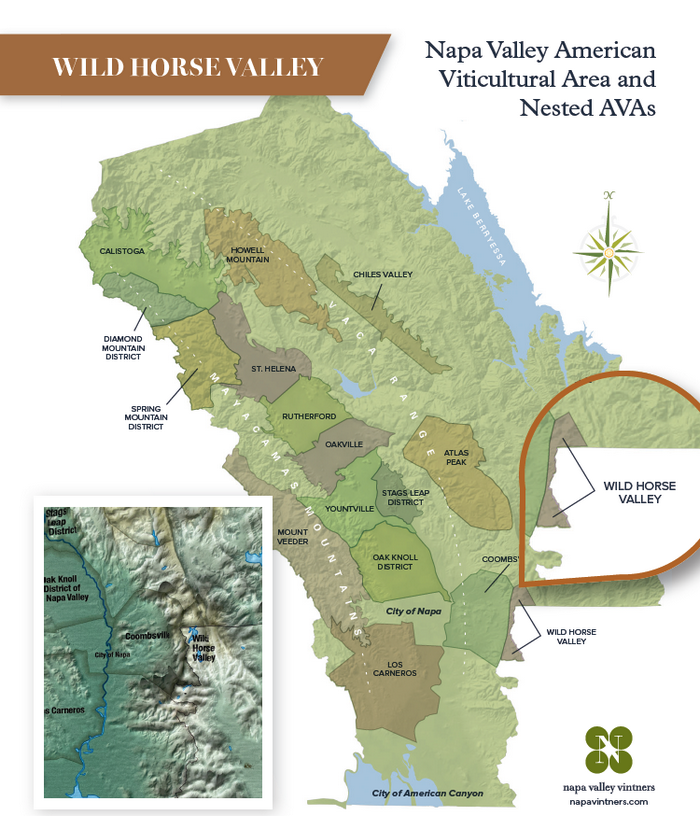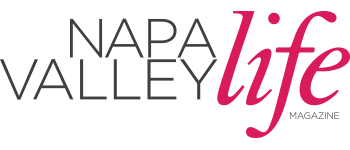One of Napa’s Hidden Gems
When farmers first began planting grapes in the Napa Valley, wild horses roamed the upland valley east of Napa town. Viticulturalists soon took notice of “Wild Horse Valley” and its unique micro-climate cooled by Pacific Ocean breezes that cross the Carneros lowlands before rising up the steep, oak-studded hillsides, and its largely frost-free Springs with delayed Autumn harvests.
Today, Wild Horse Valley is one of the region’s tiniest sub- appellations – just 3,300 acres, home to several vineyards and one distinctive winery, Olivia Brion. Blessed by ample water, well-drained soils, and the rich minerality of the rocky landscape, the area has become known for producing prized Pinot Noir, Chardonnay, and other cooler-climate varietals. But this success has been hard-won.
According to historical records, a dozen families had settled in the valley by 1873, and shortly there- after, grape growing pioneers Joseph Vorbe, Pierre Fournier, and Constance Malandrino were planting vineyards. Malandrino earned notoriety when he illegally diverted Vallejo’s municipal water for his own use, and later, when torrential winter rains destroyed his poorly-constructed dam, leading to downstream flooding, blame, and lawsuits.
A series of misfortunes befell the little valley– the economic depressions in 1893 and 1929, a phylloxera outbreak in the 1890s, and a devastating wildfire in 1913. Vineyards vanished during Prohibition. Then gasoline rationing during World War II made the area hard to reach. By 1945, there were almost no inhabitants.
Over the next few decades, homesteaders gradually returned, despite two serious wildfires in 1953 and 1964. By the 1970s, vineyard farming had resumed.
One pioneer was John Newmeyer, a San Francisco epidemiologist and wine enthusiast. In 1978 he and his friends purchased the thousand-acre Green Valley Ranch at the end of Green Valley Road. They envisioned a small vineyard.
“Rene di Rosa and I walked over a patch of land by Heron Lake,” Newmeyer recalled. “He shared my excitement about the potential of the place.” In 1980 John established Heron Lake Vineyard, planting 24 acres. Soon afterward, he met a passionate young winemaker, David Mahaffey. Sizing up the opportunity, Mahaffey soon grafted over one- third of the vines into Pinot Noir.
“If I were stranded on a desert island, and had just one bottle of wine to drink, it would be Pinot Noir,” said Mahaffey. “Pinot Noir checks off everything you could ask for in a great wine: layered complexity, a nuance that changes with every sip, and perfect food pairing capability. If you’re going to a dinner party and don’t know what’s on the menu, bring a Pinot.”

“Yields in the rocky soils are low, so the best option is to grow grapes with intensely concentrated fruit flavors from which high-value wine can be made,” Newmeyer added, “Burgundian varieties, Chardonnay and Pinot Noir, were the right choices.”
A few years later, recognizing the unique attributes of this growing region, Newmeyer and Mahaffey set about the painstaking task of applying for, and ultimately achieving, a separate AVA designation for Wild Horse Valley, which includes land in Napa and Solano counties.
Wild Horse Valley remains sparsely planted, devoted mostly to wilderness protection, watershed preservation and cattle grazing. According to Newmeyer, only about ten percent of the land is suit- able for wine grapes, and just a fraction of that is planted. That includes a portion of the gorgeous Kenzo Estate vineyard, located in the AVA’s northern reaches. The brainchild of Kenzo Tsujimoto, the vineyard boasts two superstars – viticulturist David Abreu and winemaker Heidi Barrett.
Over the years, grapes grown in Wild Horse Valley have attracted attention from some of Napa Valley’s best wineries, such as Newton Vineyard, which made Heron Lake Vine- yard grapes a staple component of its splendid “unfiltered” Chardonnays. Mahaffey’s wines, first bottled under the Heron Lake label, and later under the Olivia Brion brand, have gained a devoted following and are featured in many of the area’s best restaurants.

In 2006, John Lockwood came to help Mahaffey work the crush. Hooked by the Wild Horse Valley experience, he moved to Napa Valley, and launched his wine industry career, eventually establishing Enfield Wine Co. In 2014, the San Francisco Chronicle dubbed the Enfield 2012 Chardonnay, made from Heron Lake grapes, “Chardonnay of the Year,” describing it as “heathery, with cypress and green tea, ripe with pear and yellow raspberry.” (He was later featured prominently in the New York Times in 2018).
Lockwood remains deeply involved with the vineyard to this day, noting that “the soils are volcanic with pumice stones,” resulting in Pinot Noirs with aromas of dark plum, wild cherry, and dried ginger, and pronounced minerality.

This year, Mahaffey celebrated his 40th vintage. Another of his interns, Kira Ballotta, bitten by the Wild Horse Valley bug, joined him in 2017 as co-winemaker. Ballotta, with a discerning palate and shrewd business sense, is gradually taking over the Olivia Brion brand, as Mahaffey edges toward retirement. Among her innovations is the attention- getting proprietary white aromatic blend, Taquine, built on the back- bone of Heron Lake Chardonnay.
“We’ve had a remarkable run,” said Mahaffey, noting several of his favorite vintages, including the currently available 2016 Olivia Brion Estate Pinot Noir. “What a magnificent place to make wine.”
FOR MORE INFORMATION
Article By: Linda G. Brown // Photos By: David Mahaffey

